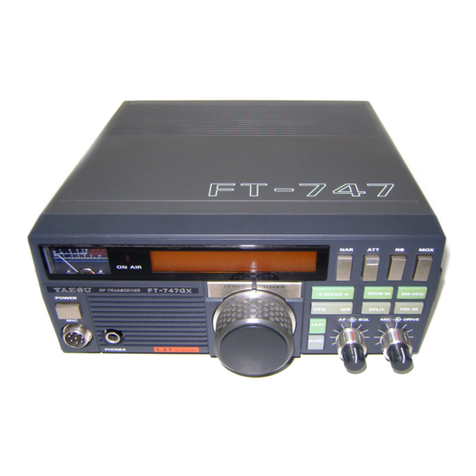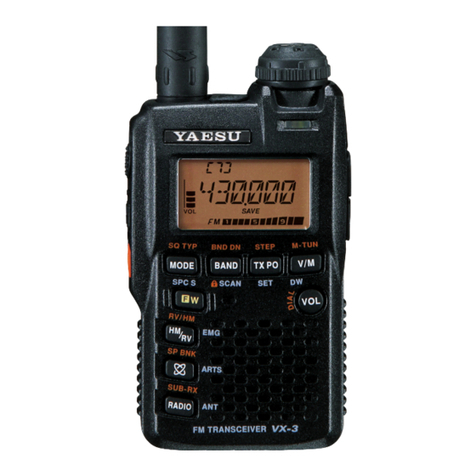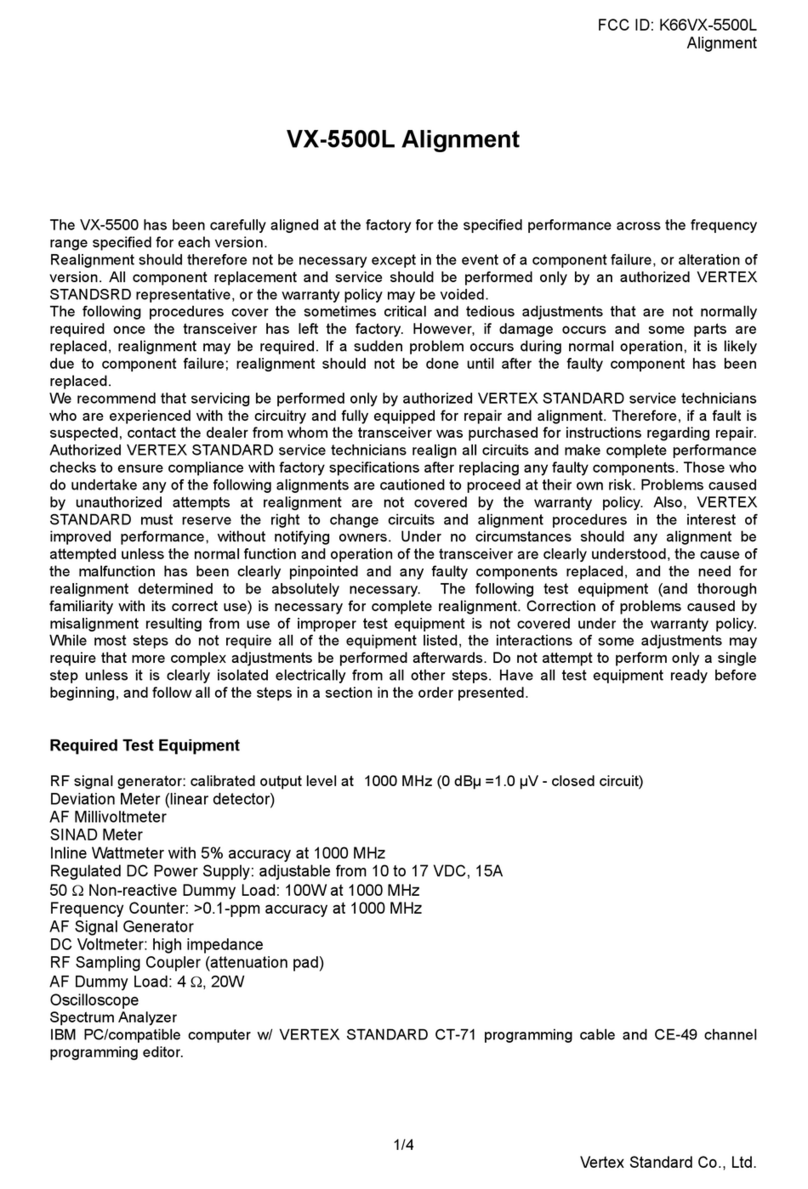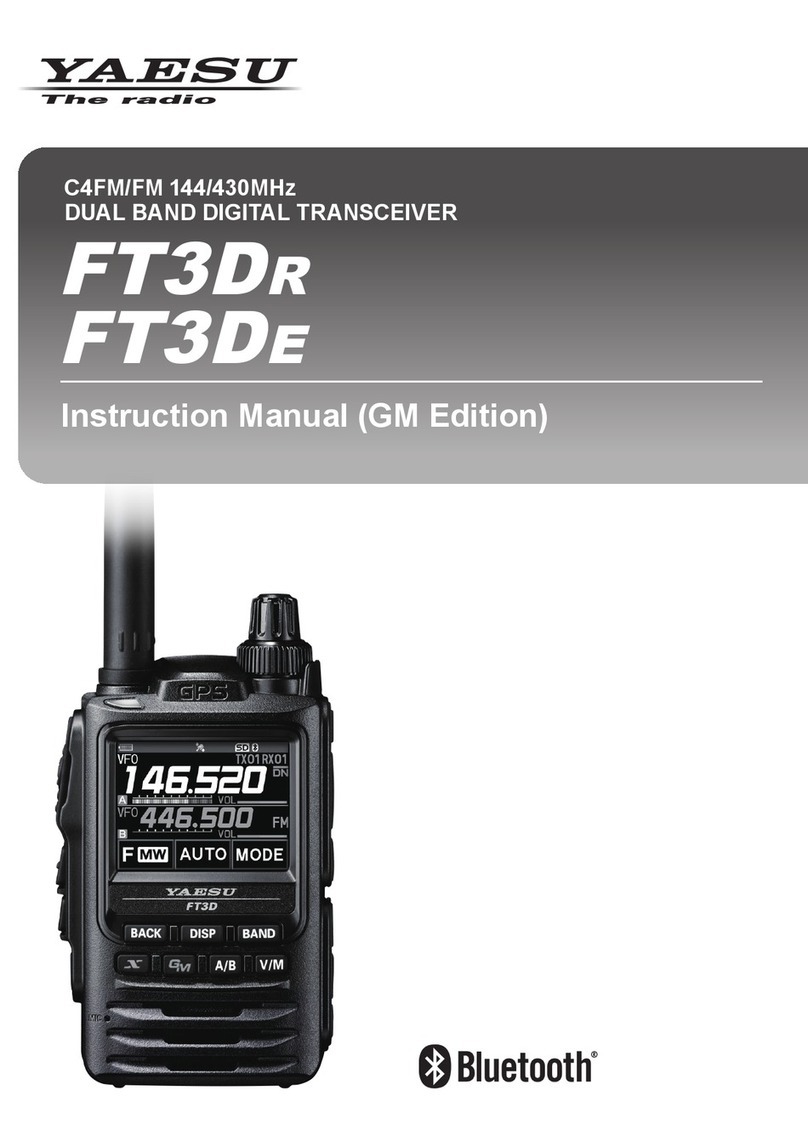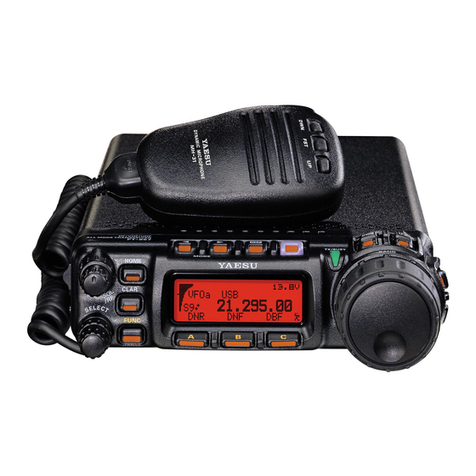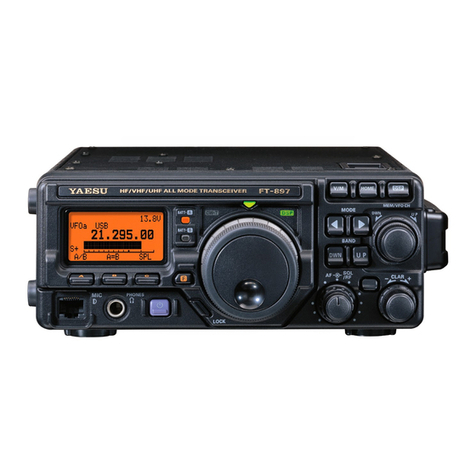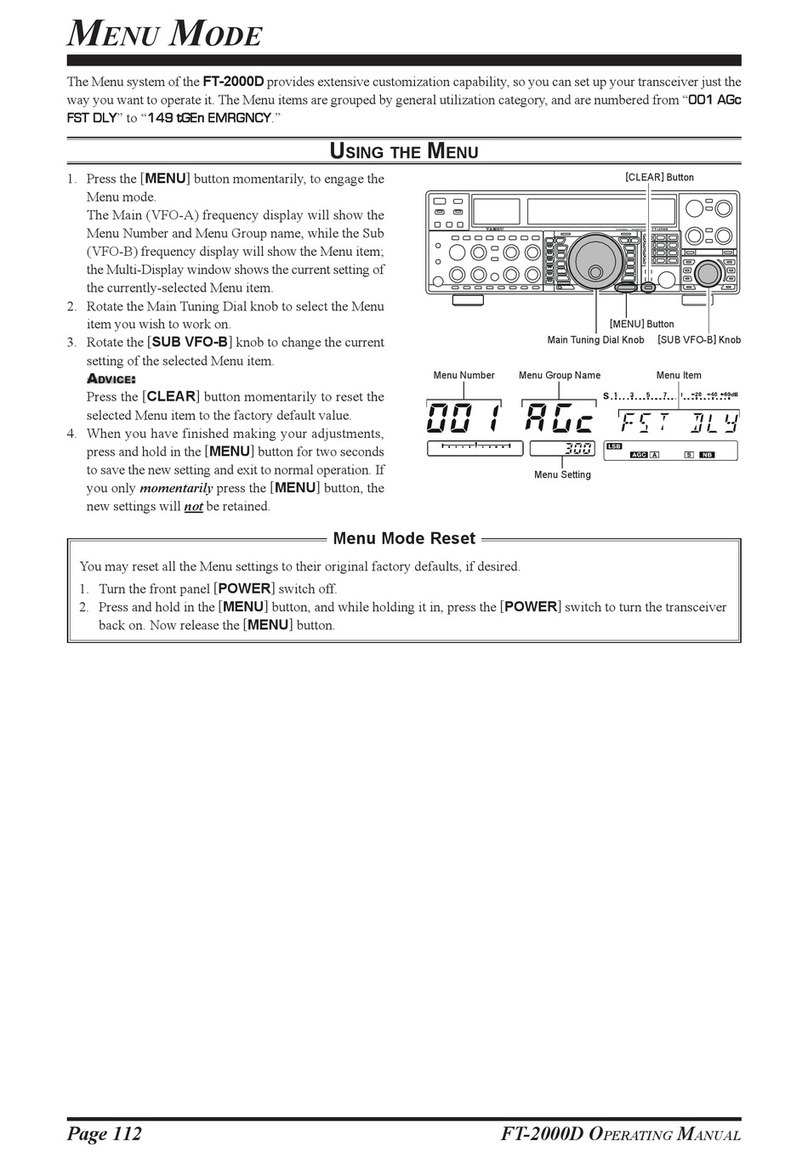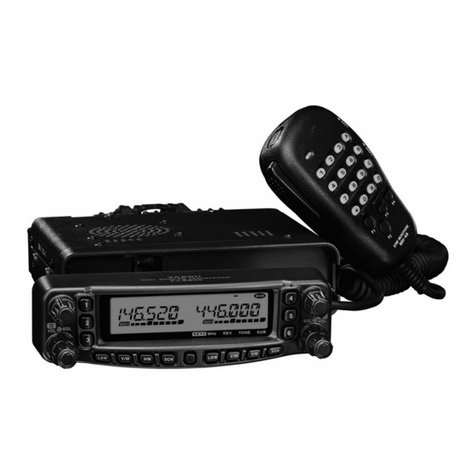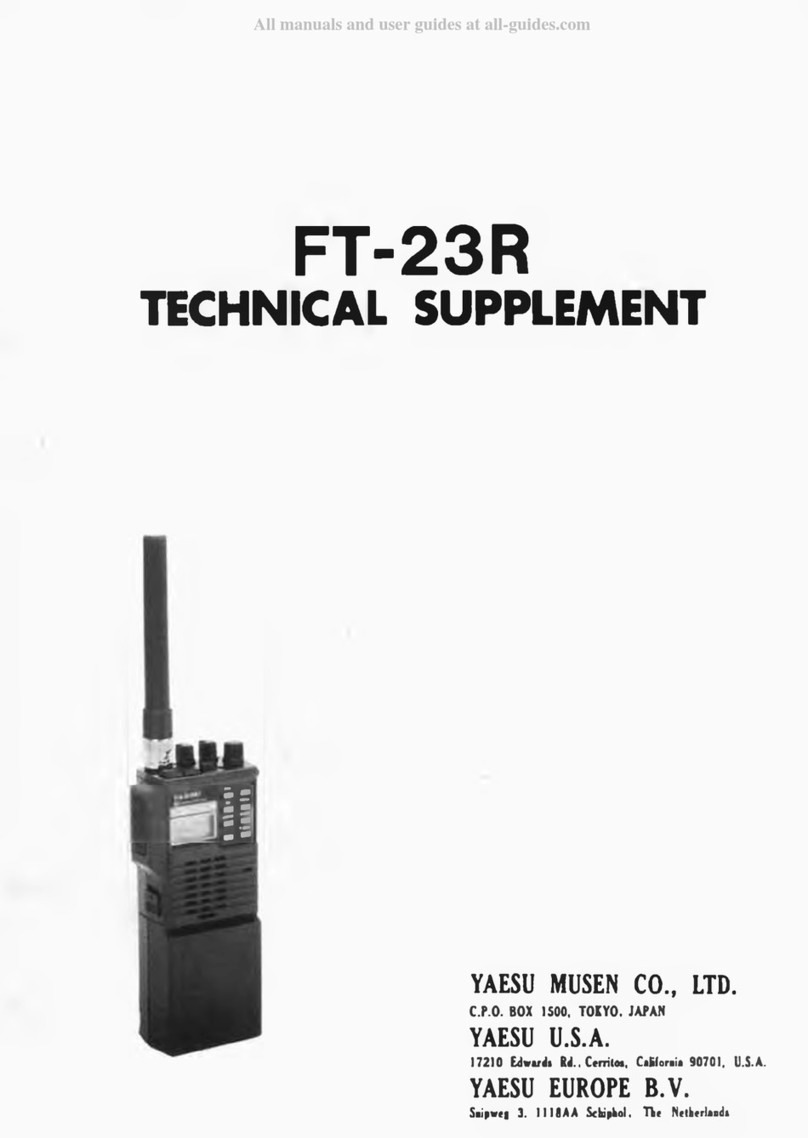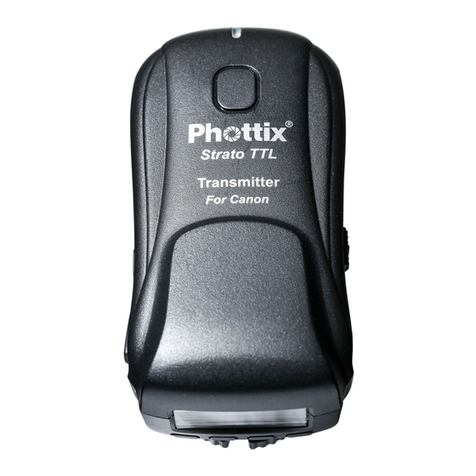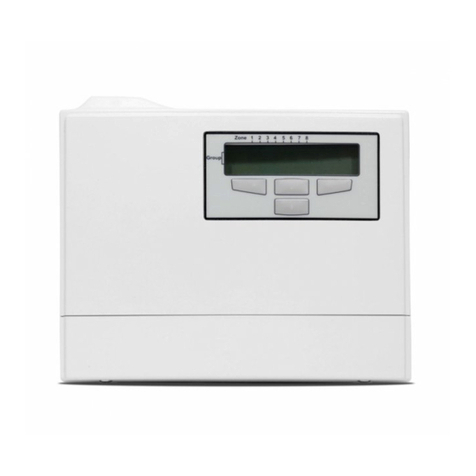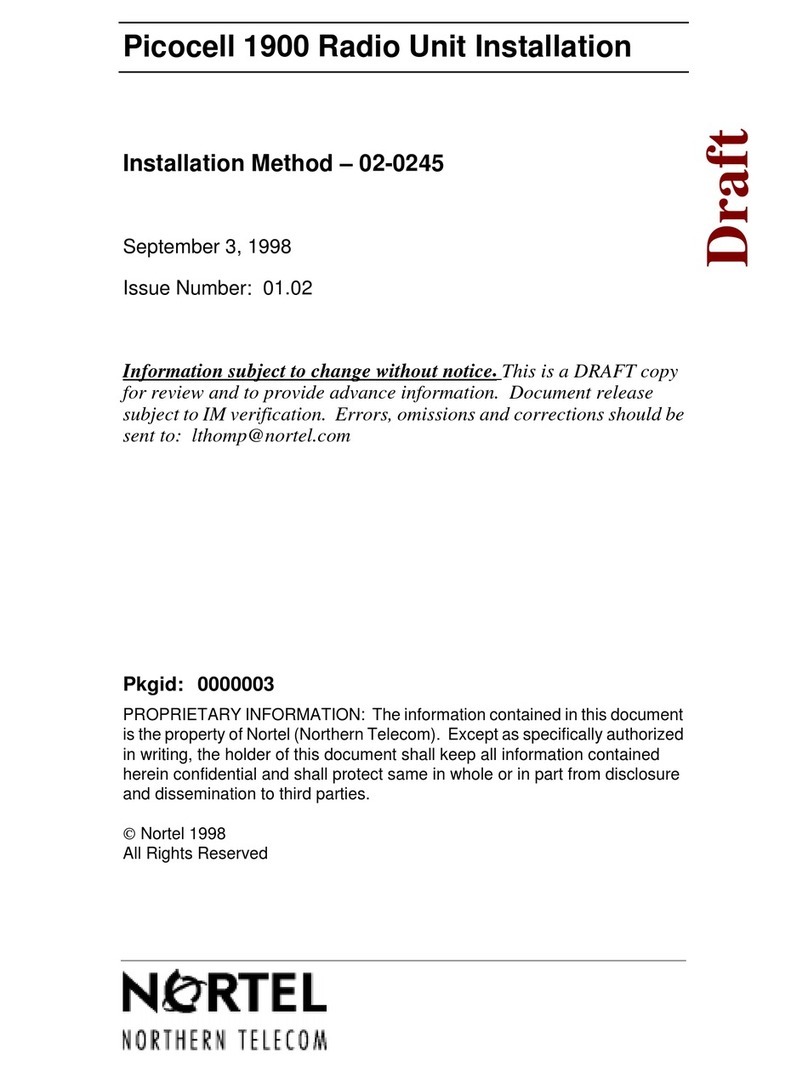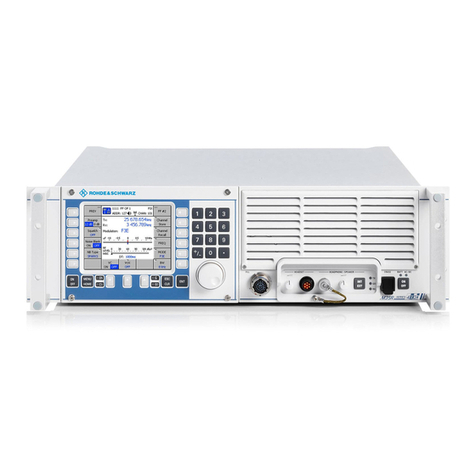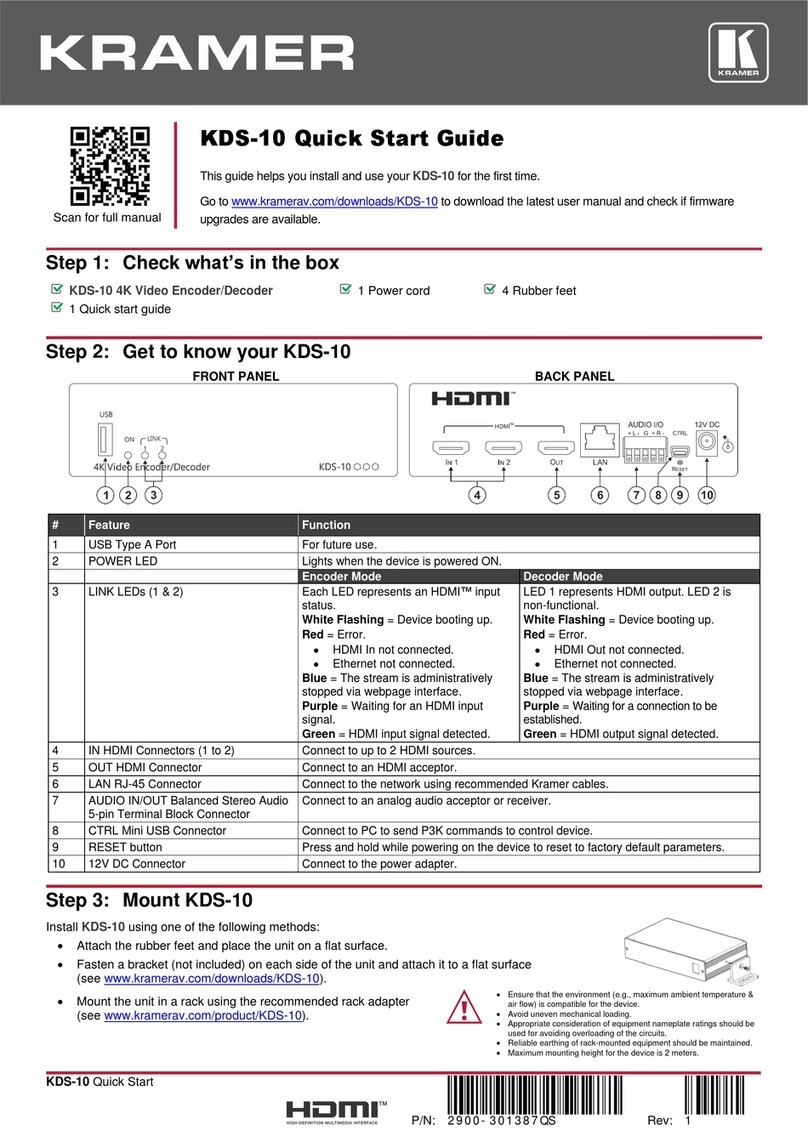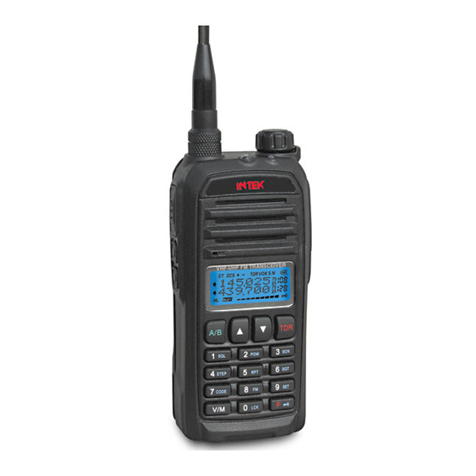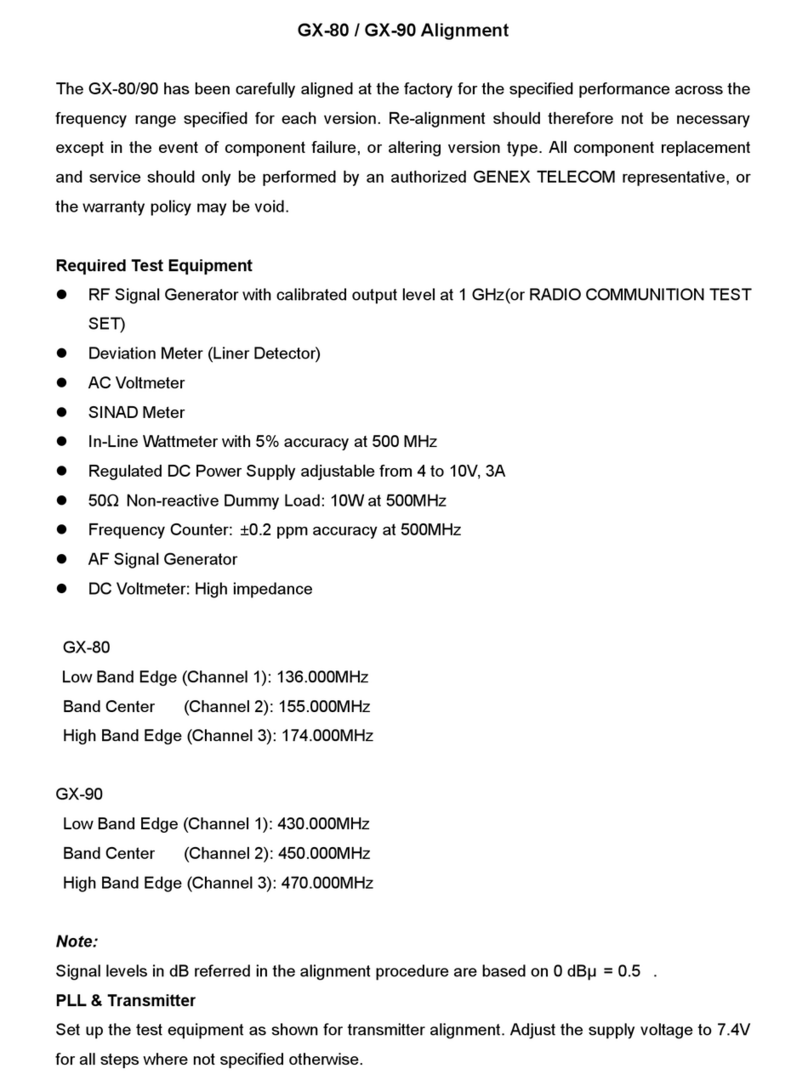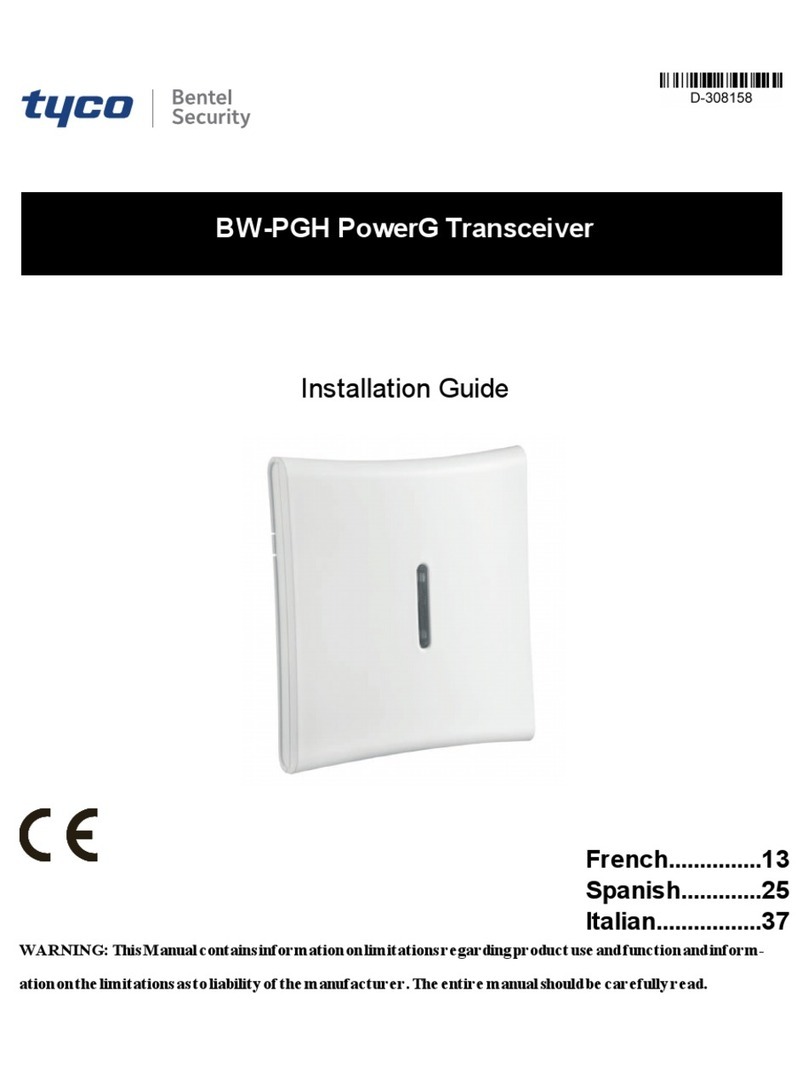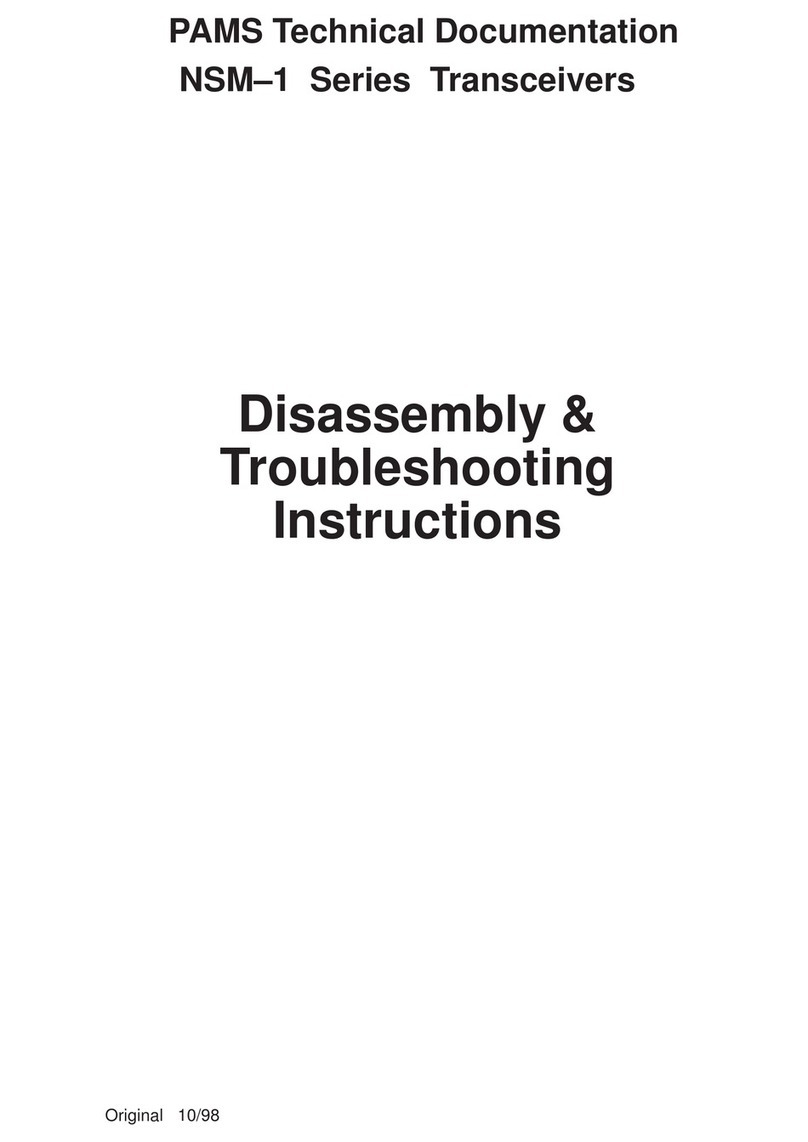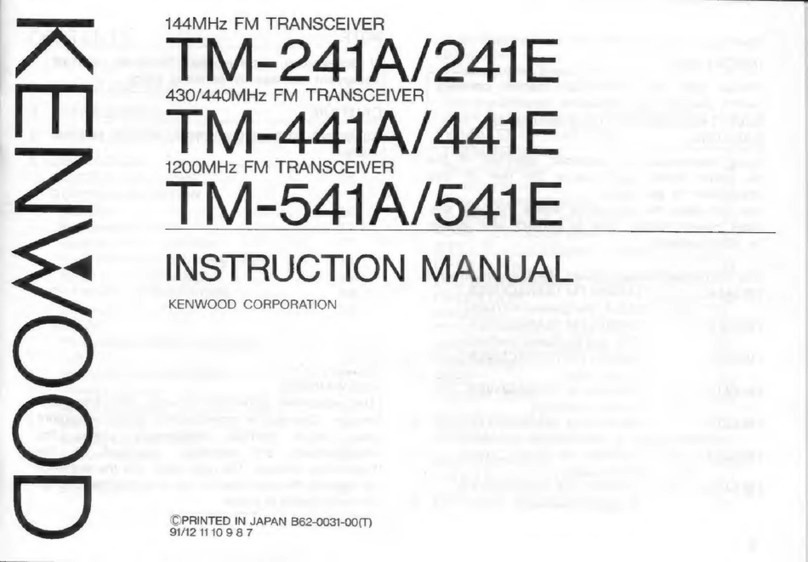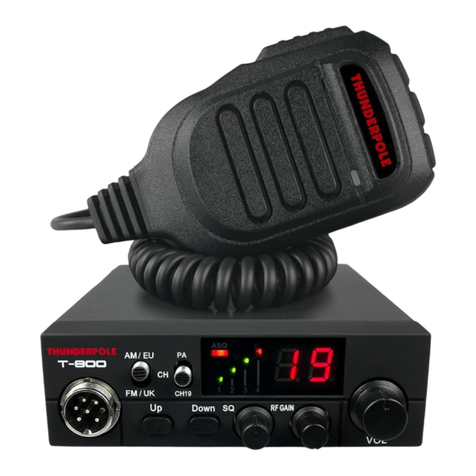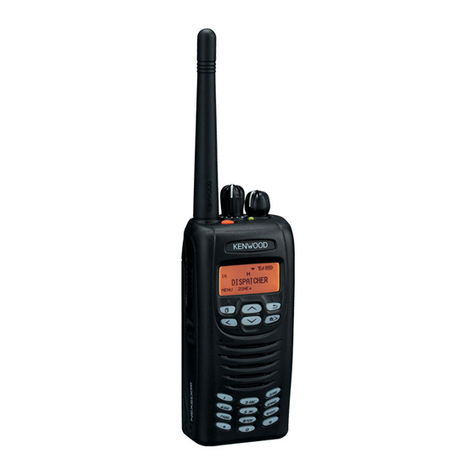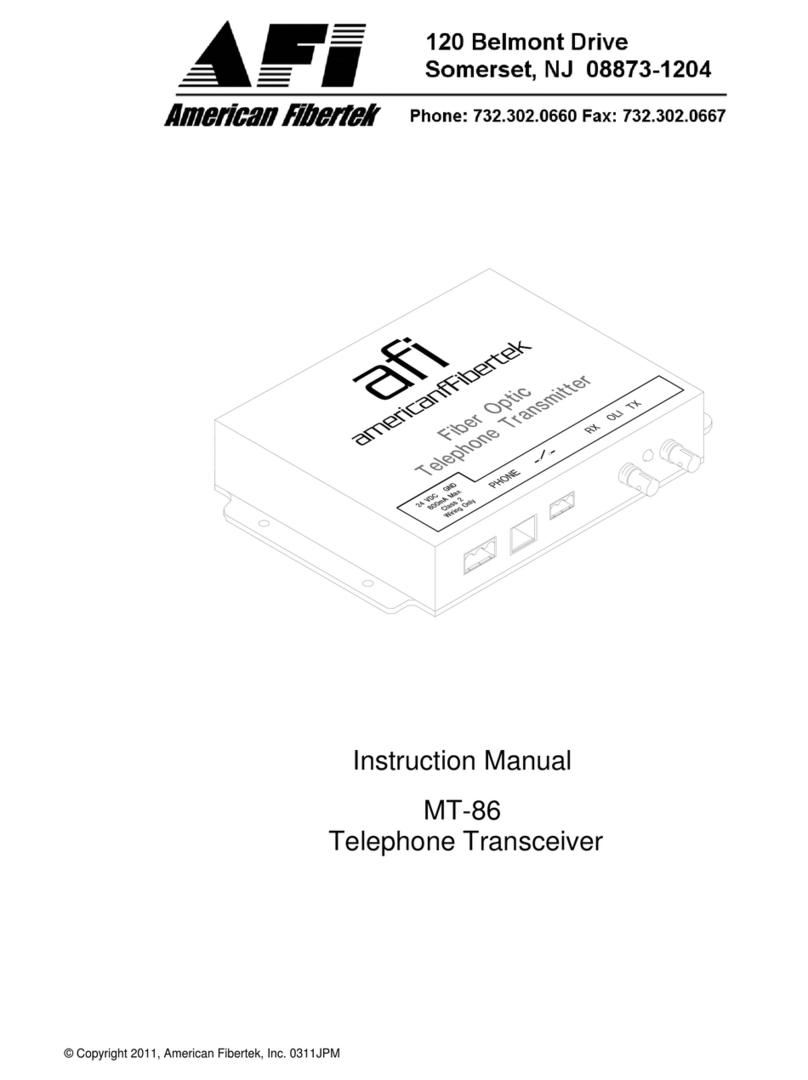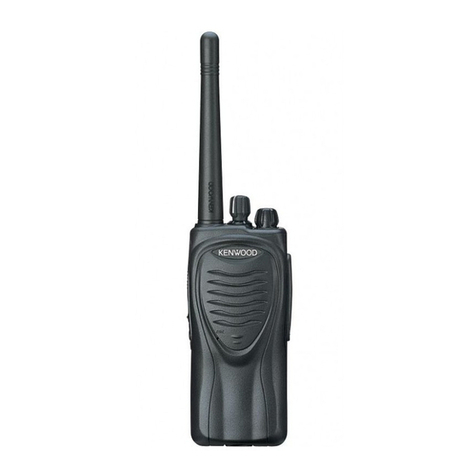Yaesu FT-2800M Manual

1
Introduction
This manual provides technical information necessary for servicing the FT-2800M FMTransceiver.
Servicing this equipment requires expertise in handling surface-mount chip components. Attempts by non-qualified per-
sons to service this equipment may result in permanent damage not covered by the warranty, and may be illegal in some
countries.
Two PCB layout diagrams are provided for each double-sided circuit board in the Transceiver. Each side of is referred to
by the type of the majority of components installed on that side (“leaded” or “chip-only”). In most cases one side has only
chip components, and the other has either a mixture of both chip and leaded components (trimmers, coils, electrolytic
capacitors, ICs, etc.), or leaded components only.
While we believe the technical information in this manual to be correct, VERTEX STANDARD assumes no liability for
damage that may occur as a result of typographical or other errors that may be present. Your cooperation in pointing out
any inconsistencies in the technical information would be appreciated.
©2003 VERTEX STANDARD CO., LTD. EH014N90A
Technical Supplement
Specifications..................................................... 2
Exploded View & Miscellaneous Parts........... 3
Block Diagram .................................................. 5
Circuit Description .......................................... 7
Alignment .......................................................... 9
Contents
Board Unit(
Schematics, Layouts & Parts
)
µCOM Unit /RF Unit Circuit Diagram ..........................13
µCOM Unit Parts Layout ..............................................15
µCOM Unit Parts List ...................................................17
RF Unit Parts Layout .....................................................21
RF Unit Parts List ..........................................................23
VERTEX STANDARD CO., LTD.
4-8-8 Nakameguro, Meguro-Ku, Tokyo 153-8644, Japan
VERTEX STANDARD
US Headquarters
10900 Walker Street, Cypress, CA 90630, U.S.A.
International Division
8350 N.W. 52nd Terrace, Suite 201, Miami, FL 33166, U.S.A.
YAESU EUROPE B.V.
P.O. Box 75525, 1118 ZN Schiphol, The Netherlands
YAESU UK LTD.
Unit 12, Sun Valley Business Park, Winnall Close
Winchester, Hampshire, SO23 0LB, U.K.
VERTEX STANDARD HK LTD.
Unit 5, 20/F., Seaview Centre, 139-141 Hoi Bun Road,
Kwun Tong, Kowloon, Hong Kong
PWR MHz REV LOW D/MR
FM TRANSCEIVER
FT-2800M

2
Specifications
General
Frequency Range:Tx 144 - 146 MHz or 144 - 148 MHz
Rx 144 - 146 MHz or 137 - 174 MHz
Channel Step:5/10/12.5/15/20/25/50/100 kHz
Standard Repeater Shift:±600 kHz
Frequency Stability:Better than ±10 ppm [–4 °F to +140 °F (–20 °C to +60 °C)]
Modes of Emission:F2/F3
Antenna Impedance:50 Ohms, unbalanced
Supply voltage:13.8 V DC ±15%, negative ground
Current Consumption (typical): Rx: less than 0.7 A, less than 0.3A (squelched)
Tx: 10 A (65 W)/7 A (25 W)/5 A (10 W)/4 A (5 W)
Operating Temperature Range:–4° F to +140° F (–20° C to +60° C)
Case Size (WxHxD): 6.3” x 2.0” x 7.3” (160 x 50 x 185 mm) (w/o knobs)
Weight (Approx.): 4.0 lb (1.8 kg)
Transmitter
Output Power:65 W/25 W/10 W/5 W
Modulation Type:Variable Reactance
Maximum Deviation:±5 kHz/±2.5 kHz
Spurious Radiation:Better than –60 dB
Microphone Impedance:2000 Ohms
Receiver
Circuit Type:Double Conversion Superheterodyne
Ifs:21.7 MHz & 450 kHz
Sensitivity (for 12dB SINAD): Better than 0.2 µV
Selectivity (–6/–60dB): 12 kHz/28 kHz
IF Rejection:Better than 70 dB
Image Rejection:Better than 70 dB
MaximumAF Output:3 W into 4 Ohms @10 % THD
Specifications subject to change without notice or obligation. Specifications guaranteed only within Amateur band

3
Exploded View & Miscellaneous Parts
Ä
Å
S8101427
CONNECTOR
S8002063
CAP-SP
S8002058
COVER-BOTTOM ASSY
À
À
À
À
À
À
Á
Á
Á
S8002052
KNOB-VOL
S8002053
KNOB-DIAL
S8002052
KNOB-VOL
Â
Â
Â
Â
Ã
Ã
Ã
Ã
ÃÃ
Ã
Ã
Ã
Å
Ä
Ä
Ä
Ä
Ä
Ä
Ä
S8101433
SPEAKER
S8101435
CABLE
(with BLADE FUSE)
S8002064
SPACER
S8002055
PLATE-EARTH
S8002057
CASE-MAIN
S8002056
REFLECTOR
µCOM Unit
S8002060
FILTER-LCD
S8002061
CONNECT-LCD
S8002059
CASE-FRONT
S8101434
LCD
S8002062
BUTTON
RF ASSY
Screw List
REF. VXSTD P/N Description Qty.
U30308007 FLAT HEAD SCREW M3x8B 6
S8002065 BOLT CAP M3x20 BZC 3
S8002066 TAPTITE SCREW 3x8ZC 4
U44306001 TAPTITE SCREW M3x6 9
S8002067 TAPTITE SCREW 3x10ZC 8
S8002068 WASHER-PLAIN 2
À
Á
Â
Ã
Ä
Å
Accessories
Description VXSTD P/N
FOOT S8002050
BRACKET S8002051
BLADE FUSEATC 15A Q0000075
CABLE ND-A35-2500CB S8101436
MIC MH48A6J AAA43X001

4
Exploded View & Miscellaneous Parts
Note

Block Diagram
5

Block Diagram
6
Note

7
Circuit Description
Reception and transmission are switched by “RX” and
“TX” lines from the microprocessor unit (MPU). The re-
ceiver uses double-conversion superheterodyne circuitry,
with a 21.7 MHz 1st IF and 450 kHz 2nd IF. The 1st lo-
cal, produced by a PLL synthesizer, yields the 21.7 MHz
1st IF.
The 2nd local uses a 21.250 MHz (21.7 MHz - 450 kHz)
signal generated by a crystal oscillator. The 2nd mixer
and other circuits use a custom IC to convert and amplify
the 2nd IF, and detect FM to obtain demodulated signals.
During transmit, the PLL synthesizer oscillates at the de-
sired frequency directly, for amplification to obtain RF
power output. During transmit, voice modulation and
CTCSS (or DCS) modulation are applied to this synthe-
sizer. Transceiver functions, such as TX/RX control, PLL
synthesizer settings, and channel programming, are con-
trolled using the MPU.
Receiver
Incoming RF signals from the antenna connector are de-
livered to the RF Unit, and pass through a lowpass filter
(LPF) consisting of coils L303, L305, and L307, capaci-
tors C303, C309, C310, and C316, and antenna switching
diodes D305 and D306 (Both MA111) for delivery to the
receiver front end.
Signals within the frequency range of the transceiver are
then passed through a varactor-tuned bandpass filter con-
sisting of diodes D308, D322, D310 and D323 (all
HVC3508), and coils L334, L335, L320 and L322 and
associated circuitry before RF amplification by Q316
(3SK240).
The amplified RF signal is then bandpass filtered again
by varactor-tuned resonators consisting of diodes D312,
D324, D313 and D325 (all HVC3508), and coils L336,
L337, L325 and L327 and associated circuitry, to ensure
pure in-band input to 1st mixer Q321 (3SK240).
Buffered output from the VCO Unit is amplified by Q318
(2SC5006) and lowpass-filtered by L339, C414, and
C413, to provide a pure 1st local signal between 112.3
and 152.3 MHz, which is delivered to the 1st mixer.
The 21.7 MHz 1st mixer product then passes through dual
monolithic crystal filter F301 (7.5 kHz BW), and is am-
plified by Q327 (2SC4215Y) and delivered to the input
of the FM IF subsystem IC Q334 (TA31136FN).
This IC contains the 2nd mixer, 2nd local oscillator, lim-
iter amplifier, FM detector, noise amplifier, S-meter am-
plifier and squelch gates.
The 2nd local in the IF-IC is produced from crystal X302
(21.250 MHz), and the 1st IF is converted to 450 kHz by
the 2nd mixer and stripped of unwanted components by
ceramic filter F302. After passing through a limiter am-
plifier, the signal is demodulated by the FM detector.
Demodulated receive audio from the IF-IC is amplified
by Q336 (2SA1588Y) and Q338 (UMX2M). After vol-
ume adjustment by the AF power amplifier Q337
(LA4425A), the audio signal is passed to the optional
headphone or 8-ohm loudspeaker.
PLL Synthesizer
The 1st local maintains stability from the PLL synthesiz-
er by using a 21.250 MHz reference signal from crystal
X301. PLL synthesizer IC Q333 (LV2105V) consists of
a prescaler, reference counter, swallow counter, program-
mable counter, a serial data input port to set these counters
based on external data, a phase comparator, and a charge
pump.
The PLL-IC divides the 21.250 MHz reference signal by
4,250 using the reference counter (5.0 kHz comparison
frequency). The VCO output is divided by the prescaler,
swallow counter and programmable counter. These two
signals are compared by the phase comparator and ap-
plied to the charge pump. A voltage proportional to their
phase difference is delivered to the low-pass filter circuit,
then fed back to the VCO as a voltage with phase error,
controlling and stabilizing the oscillating frequency. This
synthesizer also operates as a modulator during transmit.
The RX VCO is comprised of Q323 (2SC5006) and
D314/D326 (Both 1SV282), and oscillates at 21.7 MHz
during receive.
The TX VCO is comprised of Q322 (2SC5006) and
D316/D327 (Both 1SV282) and oscillates at the funda-
mental frequency during transmit, with direct frequency-
modulation using varactor diode D315 (1SV214).
The VCO output passes through buffer amplifier Q320
(2SC5005), and a portion is fed to the PLL IC, and at the
same time is amplified by Q318 (2SC5006) to obtain
stable output. Synthesizer output is fed to the 1st mixer
by diode switch D311 (1SS321) during receive, and to
pri-drive amplifier Q317 (2SC3356) for transmit.
The reference oscillator feeds the PLL synthesizer, and is
composed of crystal X301 (21.250 MHz) and transmit
(DCS) modulation circuit D317 (HVC350B).
The VCO DC supply is regulated by Q330 (2SC4617).

8
Circuit Description
Transmitter
The speech signal from the microphone is delivered via
the MIC Jack to the RF Unit; after passing through Q315
(NJM2902V) which consists of amplifier, pre-emphasis,
limiter (IDC instantaneous deviation control) and lowpass
filter, to Q319 (M6364FP) which is adjusted for opti-
mum deviation level and delivered to the TX VCO Q322.
The speech signal from the microphone and CTCSS are
FM modulated by the TX VCO of the synthesizer, while
DCS audio is modulated by the reference frequency os-
cillator of the synthesizer.
Synthesizer output, after passing through diode switch
D311 (1SS321), is amplified by pri- drivers Q317
(2SC3356) and Q314 (RD00HVS1), driver Q313
(2SK3075), and power amplifier Q305 (RD70HVS1)
to obtain full RF output. The RF energy then passes
through antenna switch D303 (XB15A407) and a low-
pass filter circuit and finally to the antenna connector.
RF output power from the final amplifier is sampled by
C318 and C324 and is rectified by D302 (1SS321).
The resulting DC is fed through Automatic Power Con-
troller Q309 (UMT1N), Q312 (DTC114), and Q311
(2SB1197) to transmitter RF amplifier Q305 and is used
to provide control of the power output.
Generation of spurious products by the transmitter is min-
imized by the fundamental carrier frequency being equal
to the final transmitting frequency, modulated directly in
the transmit VCO.
Additionally harmonic suppression is provided by a low-
pass filter consisting of L303, L305, C303, C309, C310,
and C316, resulting in more than 60 dB of harmonic sup-
pression prior to delivery of the RF

9
Alignment
Introduction and Precautions
The FT-2800M has been carefully aligned at the factory
for the specified performance at the 144 MHz amateur
band. Realignment should therefore not be necessary ex-
cept in the event of a component failure. All component
replacement and service should be performed only by an
authorized Vertex Standard representative, or the warranty
policy may be voided.
The following procedures cover the sometimes critical and
tedious adjustments that are not normally required once
the transceiver has left the factory. However, if damage
occurs and some parts are replaced, realignment may be
required. If a sudden problem occurs during normal oper-
ation, it is likely due to component failure; realignment
should not be done until after the faulty component has
been replaced.
We recommend that servicing be performed only by au-
thorized Vertex Standard service technicians who are ex-
perienced with the circuitry and fully equipped for repair
and alignment. Therefore, if a fault is suspected, contact
the dealer from whom the transceiver was purchased for
instructions regarding repair. Authorized Vertex Standard
service technicians realign all circuits and make complete
performance checks to ensure compliance with factory
specifications after replacing any faulty components.
Those who do undertake any of the following alignments
are cautioned to proceed at their own risk. Problems caused
by unauthorized attempts at realignment are not covered
by the warranty policy. Also, Vertex Standard must re-
serve the right to change circuits and alignment proce-
dures in the interest of improved performance, without
notifying owners.
Under no circumstances should any alignment be attempt-
ed unless the normal function and operation of the trans-
ceiver are clearly understood, the cause of the malfunc-
tion has been clearly pinpointed and any faulty compo-
nents replaced, and the need for realignment determined
to be absolutely necessary.
Required Test Equipment
The following test equipment (and thorough familiarity
with its correct use) is necessary for complete realign-
ment. Correction of problems caused by misalignment
resulting from use of improper test equipment is not cov-
ered under the warranty policy. While most steps do not
require all of the equipment listed, the interactions of some
adjustments may require that more complex adjustments
be performed afterwards. Do not attempt to perform only
a single step unless it is clearly isolated electrically from
all other steps. Have all test equipment ready before be-
ginning, and follow all of the steps in a section in the
order presented.
rRegulated DC Power Supply: adjustable from 10 to
17 VDC, 15 A
rRF Signal Generator with calibrated output level at
200 MHz
rFrequency Counter: ±0.1 ppm accuracy at 200 MHz
rAF Signal Generator
rSINAD Meter
rDeviation Meter (linear detector)
rAF Milivoltmeter
rAF Dummy Load: 8-Ohm, 5 W
rDC Voltmeter: high impedance
rInline Wattmeter with 5% accuracy at 200 MHz
r50-Ohm non-reactive Dummy Load:
r100 watts at 200 MHz
rVHF Sampling Coupler
Set up the test equipment as shown for the transceiver
alignment, and apply 13.8 VDC power to the transceiver.
Alignment Preparation & Precautions
A dummy load and inline wattmeter must be connected to
the antenna jack in all procedures that call for transmis-
sion, except where specified otherwise. Correct alignment
is not possible with an antenna. After completing one step,
read the following step to determine whether the same
test equipment will be required. If not, remove the test
equipment (except dummy load and wattmeter, if connect-
ed) before proceeding.
Correct alignment requires that the ambient temperature
in the repair shop be the same as that of the transceiver
and test equipment, and that this temperature be held con-
stant between 68 oC and 86 oF (20 oC ~ 30 oC). When
the transceiver is brought into the shop from hot or cold
air it should be allowed some time for thermal equaliza-
tion with the environment before alignment. If possible,
alignments should be made with oscillator shields and cir-
cuit boards firmly affixed in place. Also, the test equip-
ment must be thoroughly warmed up before beginning.
Notes: Signal levels in dB referred to in alignment are
based on 0 dBµ = 0.5 µV.

10
Entering the Alignment mode
Alignment of the FT-2800M is performed using a front-
panel software-based procedure. To perform alignment
of the transceiver, it must first be placed in the “Align-
ment Mode,” in which the adjustments will be made and
then stored into memory.
To enter the Alignment mode:
1. Press and hold in the [LOW]key and [D/MR]key
while turning the radio on. Once the radio is on, re-
lease these two keys.
2. Press and hold the [MHz]key for one second to acti-
vate the “Set” (Menu) mode.
3. Rotate the DIAL knob to select “35 D/ASMT,” then
press the [MHz]key.
4. You will now note the appearance of “REF” on the
display, this signifies that the transceiver is now in
the “Alignment mode.”
PLL Reference Frequency (REF)
1. Tune the transceiver to 146.000 MHz.
2. Set the transceiver toAlignment mode, then rotate the
DIAL knob to set theAlignment parameter to “REF.”
3. Press the PTT switch to activate the transmitter, and
press the [REV]or [D/MR]key, as needed, so that
the counter frequency reading is 146.000 MHz.
4. Press and hold the [LOW]key for one second to save
the new setting.
5. Press and hold the [MHz]key for one second to exit
to the normal operation.
PLL VCO
1. Connect the DC voltmeter toTP-RVC on the RF Unit.
2. Tune the frequency to 146.000 MHz.
3. Adjust L330 on the RF Unit for 1.5 V on the DC volt-
meter.
4. Connect the DC voltmeter to TP-TVC on the RF Unit.
5. Press the PTT switch to activate the transmitter, and
adjust L329 on the RF Unit for 1.3 V on the DC volt-
meter.
RF Front-end Tuning
(TUN137/TUN146/TUN160/TUN173)
1. Connect the DC voltmeter to the Test Point (RSSI:
Pin 6 of J307) on the RF Unit.
2. Tune the transceiver to 137.050 MHz.
3. Set the transceiver toAlignment mode, then rotate the
DIAL knob to set the Alignment parameter to
“TUN137.”
4. Inject a 137.050 MHz signal at a level of –5 dBµ (with
1 kHz modulation @ ±3.5 kHz deviation) from the
RF Signal Generator.
5. Press the [REV]or [D/MR]key for maximum deflec-
tion of the DC voltmeter.
6. Press and hold the [LOW]key for one second to save
the new setting, then press and hold the [MHz]key
for one second to exit to the normal operation.
7. Tune the transceiver to 146.050 MHz.
8. Set the transceiver toAlignment mode, then rotate the
DIAL knob to set the Alignment parameter to
“TUN146.”
Alignment
RF UNIT ALIGNMNT POINTS
L329
RSSI
L330
TP-TVC
TP-RVC

11
9. Inject a 146.050 MHz signal at a level of –5 dBµ (with
1 kHz modulation @ ±3.5 kHz deviation) from the
RF Signal Generator.
10. Press the [REV]or [D/MR]key for maximum
def4lection of the DC voltmeter and maximum de-
flection of the SINAD meter.
11. Press and hold the [LOW]key for one second to save
the new setting, then press and hold the [MHz]key
for one second to exit to the normal operation.
12. Tune the transceiver to 160.050 MHz.
13. Set the transceiver toAlignment mode, then rotate the
DIAL knob to set the Alignment parameter to
“TUN160.”
14. Inject a 160.050 MHz signal at a level of –5 dBµ (with
1 kHz modulation @ ±3.5 kHz deviation) from the
RF Signal Generator.
15. Press the [REV]or [D/MR]key for maximum deflec-
tion of the DC voltmeter voltmeter at the higher side
of the bandpass filter peaks.
16. Press and hold the [LOW]key for one second to save
the new setting, then press and hold the [MHz]key
for one second to exit to the normal operation.
17. Tune the transceiver to 173.050 MHz.
18. Set the transceiver toAlignment mode, then rotate the
DIAL knob to set the Alignment parameter to
“TUN173.”
19. Inject a 173.050 MHz signal at a level of –5 dBµ (with
1 kHz modulation @ ±3.5 kHz deviation) from the
RF Signal Generator.
20. Press the [REV]or [D/MR]key for maximum deflec-
tion of the DC voltmeter at the higher side of the
bandpass filter peaks.
21. Press and hold the [LOW]key for one second to save
the new setting, then press and hold the [MHz]key
for one second to exit to the normal operation.
S-Meter Sensitivity (SMTL 10/SMTL 2)
1. Set the transceiver toAlignment mode, then rotate the
DIAL knob to set theAlignment parameter to “SMTL
10.”
2. Inject a 146.050 MHz signal at a level of +25 dBµ
(with 1 kHz modulation @ ±3.5 kHz deviation) from
the RF Signal Generator.
3. Press and hold the [LOW]key for one second to save
the new setting.
4. Rotate the DIAL knob one click to clockwise to set
the Alignment parameter to “SMTL 2.”
5. Reduce the RF Signal Generator output level to –5
dBµ.
6. Press and hold the [LOW]key for one second to save
the new setting.
7. Press and hold the [MHz]key for one second to exit
to the normal operation.
TX Power Output
(TXPW H/TXPW M/TXPW L2/TXPW L1)
1. Tune the transceiver to 146.000 MHz, and set the
Transmitter Power Level to “HIGH.”
2. Set the transceiver toAlignment mode, then rotate the
DIAL knob to set theAlignment parameter to “TXPW
H.”
3. Press the PTT switch to activate the transmitter, and
press the [REV]or [D/MR]key for 65 Watts on the
wattmeter, and confirm that supply current remains
below 12.5 A.
4. Press and hold the [LOW]key for one second to save
the new setting, then rotate the DIAL knob one click
to clockwise to set the Alignment parameter to
“TXPW M.”
5. Press the PTT switch to activate the transmitter, and
press the [REV]or [D/MR]key for 25 Watts on the
wattmeter, and confirm that supply current remains
below 7.5 A.
6. Press and hold the [LOW]key for one second to save
the new setting, then rotate the DIAL knob one click
to clockwise to set the Alignment parameter to
“TXPWL2.”
7. Press the PTT switch to activate the transmitter, and
press the [REV]or [D/MR]key for 10 Watts on the
wattmeter, and confirm that supply current remains
below 5 A.
8. Press and hold the [LOW]key for one second to save
the new setting, then rotate the DIAL knob one click
to clockwise to set the Alignment parameter to
“TXPWL1.”
9. Press the PTT switch to activate the transmitter, and
press the [REV]or [D/MR]key for 5 Watts on the
wattmeter, and confirm that supply current remains
below 4 A.
10. Press and hold the [LOW]key for one second to save
Alignment

12
the new setting, then press and hold the [MHz]key
for one second to exit to the normal operation.
TX Deviation (MODWFM/MODNFM)
1. Tune the transceiver to 146.000 MHz.
2. Inject a 1 kHz audio tone at a level of 60 mV from the
Audio Generator.
3. Set the transceiver toAlignment mode, then rotate the
DIAL knob to set the Alignment parameter to
“MODWFM.”
4. Press the PTT switch to activate the transmitter, and
press the [REV]or [D/MR]key so that the deviation
meter reading is 4.2 kHz.
5. Press and hold the [LOW]key for one second to save
the new setting, then rotate the DIAL knob one click
to clockwise to set the Alignment parameter to
“MODNFM.”
6. Press the PTT switch to activate the transmitter, and
press the [REV]or [D/MR]key so that the deviation
meter reading is 2.1 kHz.
7. Press and hold the [LOW]key for one second to save
the new setting, then press and hold the [MHz]key
for one second to exit to the normal operation.
CTCSS TX Deviation (TONE W/TONE N)
1. Tune the transceiver to 146.000 MHz.
2. Set the CTCSS tone to 100 Hz.
rPress and hold the [MHz]key for one second to
activate the “Set” (Menu) mode.
rRotate the DIAL knob to select “27 SQ TNF.”
rPress the [MHz]key momentarily, then rotate the
DIAL knob to select to 100.0 (Hz).
rPress and hold the [MHz]key for one second to
exit to the normal operation
3. Set the transceiver toAlignment mode, then rotate the
DIAL knob to set theAlignment parameter to “TONE
W.”
4. Press the PTT switch to activate the transmitter, and
press the [REV]or [D/MR]key so that the deviation
meter reading is 0.6 kHz.
5. Press and hold the [LOW]key for one second to save
the new setting, then rotate the DIAL knob one click
to counter clockwise to set the Alignment parameter
to “TONE N.”
6. Press the PTT switch to activate the transmitter, and
press the [REV]or [D/MR]key so that the deviation
meter reading is 0.3 kHz.
7. Press and hold the [LOW]key for one second to save
the new setting, then press and hold the [MHz]key
for one second to exit to the normal operation.
Alignment

µCOM Unit /RF Unit Circuit Diagram
13
13.65V
(13.47V)
6.55V
(6.52V)
1.07V
(1.06V)
4.42V
(0V)
4.75V
(0V)
2.45V
(0V)
2.94V
(0V)
7.93V
(0V)
1.98V
(0V)
1.95V
(0V)
1.3V
(0V)
2.09V
(0V)
0.65V
(0V)
0.96V
(0V)
0V
(0V)
5.6V
(0V) 1.24V
(0V)
5.6V
(0V)
4.74V(0V)
5.23V(0V) 0.65V
(0V)
0.72V(0V)
5.23V
(0V)
4.39V
(0V)
5.07V
(0.2V)
5.57V
(0V)
0V
(1.49V)
7.15V
(2V)
0V
(0V)
4.84V
(4.84V)
0V
(0V)
2.55V
(2.55V)
4.4V
(4.4V)
4.18V
(4.38V)
4.89V
(4.89V)
0V(0V)
4.94V
(4.94V)
1.33V
(0.77V)
4.93V
(4.93V)
2.47V
(2.48V)
4.94V
(4.94V)
3.24V
(3.24V)
3.76V
(3.76V)
4.79V
(4.79V)
1.85V
(1.85V)
4.97V
(4.97V)
0V
(0V)
7.2V
(0.4V)
1.5V
(0.2V)
7.2V
(0V)
4.38V
(0V)
0V
(4.11V)
7.25V
(0V)
0V
(7.22V)
1.51V
(0V)
0V
(7.26V)
7.94V
(7.94V)
7.98V
(7.98V)
7.26V
(7.26V)
5.1V
(0V)
5.1V
(0V)
0.71V
(0V)
7.41V
(0V)
7.33V
(0V)
0V
(0V)
pin1:0V(4.96V)
pin2:4.93V(4.93V)
pin3:0V(0V)
pin4:13.78V(13.78V)
pin5:4.95V(4395V)
pin6:1.99V(2V)
pin7:0.1V(0.1V)
pin8:7.97V(7.97V)
pin9:0V(0V)
pin10:0V(0V)
pin11:0V(0V)
pin12:0V(2.46V)
5.03V
(5.03V)
4.99V
(1.2V)
J110
pin1:4.99V(4.99V)
pin2:4.99V(4.99V)
pin3:7.96V(7.96V)
pin4:0V(0V)
pin5:0V(0V)
pin6:4.99V(1V)
7.97V
(7.97V)
6.9V
(6.9V)
5.04V
(5.04V)
0V
(0V)
13V
(13V)
0V
(0V)
5.03V
(5.03V)
2.74V
(2.74V)
0.89V
(0.89V)
CLK SHT
ON:0V(0V)
0FF:4.99V(4.99V)
4.93V
(4.93V)
0V
(0V)
0.1V
(0.1V)
4.99V
(4.99V)
0V
(0V)
(DTMF ON 2.46V)
0V
(0V)
5.03V
(5.03V)
5.03V
(5.03V)
5.03V
(5.03V)
2.34V
(2.34V)
2.38V
(2.38V)
5.03V
(5.03V)
0V
(0V)
4.99V
(4.99V)
5.03V
(5.03V)
5.03V
(5.03V)
0V
(0V)
(DCS ON 2.3V)
4.89V
(4.89V)
3.26V
(3.26V)
1.64V
(1.64V) 0V
(0V)
5.03V
(5.03V)
0V
(0V)
0V
(0V)
4.99V
(4.99V)
DIMR
OFF:4.01V(4.01V)
1:2.52V(2.52V)
2:2.2V(2.2V)
3:1.96V(1.96V)
DIMR
OFF:0V(0V)
1:0.67V(0.67V)
2:0.89V(0.89V)
3:1.2V(1.2V)
DIMR
OFF:0V(0V)
1:0.02V(0.02V)
2:0.21V(0.21V)
3:0.5V(0.5V)
DIMR
OFF:0V(0V)
1:0.67V(0.67V)
2:0.89V(0.89V)
3:1.2V(1.2V)
DIMR
OFF:0V(0V)
1:0.02V(0.02V)
2:0.22V(0.22V)
3:0.5V(0.5V)
DIMR
OFF:3.88V(3.88V)
1:2.54V(2.54V)
2:2.17V(2.17V)
3:1.91V(1.91V)
4.87V
(4.87V)
5.03V
(5.03V)
5.03V
(5.03V)
4.76V
(4.76V)
4.76V
(4.76V)
4.76V
(4.76V)
4.76V
(4.76V)
0V
(0.2V)
0V
(0.7V)
5.03V
(5.03V)
1.83V
(1.83V)
2.03V
(2.03V)
4.95V
(4.95V) 2.02V
(2.02V)
2.03V
(2.03V)
2.02V
(2.02V)
2.03V
(2.03V)
WALT
ON:0V(0v)
OFF:4.99V(4.99V)
0V
(0V)
0V
(4.97V)
5V
(5V)
5.03V
(5.03V)
5.03V
(5.03V)
0V
(0V)
5.03V
(5.03V)
CLK SHT
ON:0V(0V)
OFF:4.99V(4.99V)
DCS/TSQ
ON:0V(0V)
OFF:5.03V(5.03V)
DCS/Tone freq.<150Hz:4.96V(4.96V)
DCS/Tone freq.>150Hz:0V(0V)
5.03V
(5.03V) 4.99V
(4.99V)
0V
(0V)
SQL
ON:5.03V(5.03V)
OFF:0V(0V)
DCS/Tone freq.<150Hz:0V(0V)
DCS/Tone freq.>150Hz:0.1V(0.1V)
2.03V
(2.03V)
1.84V
(1.84V)
1.98V
(1.98V)
0.14V
(0.14V)
2.1V
(2.1V)
2.07V
(2.07V)
2.03V
(2.03V) 2.03V
(2.03V)
2.02V
(2.02V)
1.87V
(1.87V)
4.95V
(4.95V)
0V
(0V)
DCS/Tone freq.<150Hz:0V(0V)
DCS/Tone freq.>150Hz:0.3V(0.3V)
DCS/TSQ
ON:0V(0V)
OFF:4.99V(4.99V)
0V
(0V)
0V
(0V)
pin1:0V(0V)
pin2:0V(0V)
pin3:0V(0V)
pin5:5.01V(5.01V)
pin6:1.3V(0V)
pin8:0V(0V)
pin9:5V(5V)
pin10:0V(0V)
pin11:5.03V(5.03V)
pin12:0V(0V)
RX(TX)
RX Frequency:146.1MHz
TX Frequency:146MHz
(Power Output 5W)
pin 12 pin 13 pin 14
OFF 0V(0V) 0V(0V) 0V(0V)
10V(0V) 0V(0V) 4.98V(4.98V)
20V(0V) 4.97V(4.97V) 0V(0V)
34.97V(4.97V) 0V(0V) 0V(0V)
DIMR
Q106
Q319
pin1:0V(3.98V)
pin2:4.38V(4.34V)
pin3:1.95V(1.96V)
pin4:0V(0V)
pin5:4.94V(4.94V)
pin6:0V(0.39V)
pin7:0.56V(0V)
pin8:4.94V(3.32V)
pin9:0V(0V)
pin10:4.38V(4.38V)
pin11:4.38V(0.28V)
pin12:0V(0V)
pin13:0V(0V)
pin15:0V(0.18V)
pin16:0V(0V)
pin17:4.94V(4.72V)
pin18:4.38V(4.38V)
pin19:4.91V(4.91V)
pin20:0V(0V)
pin21:0V(0V)
pin22:1.98V(1.98V)
pin23:4.38V(4.23V)
pin24:4.36V(4.36V)
5.37V
(5.28V)
6.65V
(6.65V) 6.92V
(0V)
0.74V
(0.29V)
0V
(6.98V)
0V
(1.29V)
0V
(1.79V)
0V
(2.24V) 0V
(1.41V)
1.47V
(0V)
1.51V
(0V)
1.86V
(0V)
7.21V
(0V)
0.71V
(0V)
4.52V
(5V)
1.82V
(1.82V)
1.82V
(1.82V)
5.42V
(0V)
7.15V
(0V)
5.3V
(0V)
0V
(3.2V)
0.36V
(0V)
7.58V
(0V)
3.88V
(0V)
0V
(0V)
1.82V
(1.82V)
0V
(0V)
0V
(2.5V)
HI(65W):13.79V(13.23V)
M(25W):13.79V(13.49V)
L2(10W):13.79V(13.58V)
L1(5W):13.79V(13.55V)
HI(65W):13.79V(13.31V)
M(25W):13.79V(13.56V)
L2(10W):13.79V(13.74V)
L1(5W):13.79V(13.66V)
HI(65W):13.79V(13.31V)
M(25W):13.79V(13.52V)
L2(10W):13.79V(14.16V)
L1(5W):13.79V(13.79V)
HI(65W):0V(7.89V)
M(25W):0V(7.9V)
L2(10W):0V(7.9V)
L1(5W):0V(7.9V)
HI(65W):0V(2.99V)
M(25W):0V(2.44V)
L2(10W):0V(1.6V)
L1(5W):0V(1.25V)
HI(65W):0V(2.43V)
M(25W):0V(2.04V)
L2(10W):0V(1.11V)
L1(5W):0V(0.76V)
HI(65W):0V(2.65V)
M(25W):0V(0.37V)
L2(10W):0V(0.35V)
L1(5W):0V(0.35V)
HI(65W):0V(1.26V)
M(25W):0V(7.39V)
L2(10W):0V(7.40V)
L1(5W):0V(7.42V)
HI(65W):0V(7.24V)
M(25W):0V(7.47V)
L2(10W):0V(7.56V)
L1(5W):0V(7.81V)
HI(65W):0V(7.89V)
M(25W):0V(4.21V)
L2(10W):0V(3.23V)
L1(5W):0V(2.82V)
1.86V
(1.87V) 1.95V
(2.51V)
1.93V
(2.53V)
1.94V
(2.47V)
4.95V
(4.95V)
0V
(1.96V)
3.29V
(3.29V)
1.93V
(1.93V)
1.95V(1.95V)
Q319 pin 14
HI(65W):0.64V(3.77V)
M(25W):0.64V(1.75V)
L2(10W):0.64V(1.1V)
L1(5W):0.64V(0.96V)
4.4V
(0V)
4.95V
(4.95V)
7.98V
(7.98V)
13.66V
(13.48V)
13.07V
(12.94V)
13.75V
(13.62V)
13.8V
0V
(0V) 4.18V(4.18V) 7.98V
(7.24V)
7.97V
(0V)
0V
(4.97V)
0V
(7.96V)
7.29V
(7.27V)
7.95V
(0V)

µCOM Unit /RF Unit Circuit Diagram
14
Note

15
µCOM Unit Parts Layout
ABCDEFG
1
2
abcdefg
1
2
Side A
Side B
2SJ144Y (VY)
(Q101, 107, 135)
NJM2902V
(Q102)
DTC144EU (26)
(Q103, 104, 130, 136, 137)
NJM2904V
(Q105)
BU4094BCFV
(Q106, 109)
2SC4617R (BR)
(Q110, 111, 115, 130, 132)
CAT24WC64JI
(Q112)
R1150H006B
(Q116)
1SS302 (C3)
(D101, 102, 116, 118)
DAP202U (P)
(D104, 105)
HD6473877H
(Q113)

16
µCOM Unit Parts Layout
Note

17
REF DESCRIPTION VALUE V/W TOL. MFR'S DESIG VXSTD P/N VERS.
LOT
SIDE
LAY ADR
µCOM Unit Parts List
PCB with Components S8101442 A2 (USA)
C101 CHIP CAP. 1uF 10V BGRM188B11A105KA61D S8101390 1-
C102 CHIP CAP. 0.1uF 16V BGRM39B104K16PT K22124805 1-
C103 CHIP CAP. 0.015uF 50V BGRM188B11H221KD01D S8101391 1-
C104 CHIP CAP. 1uF 6.3V BGRM39B105K6.3PT K22084801 1-
C105 CHIP CAP. 0.0027uF 50V BGRM39B272K50PT K22174829 1-
C106 CHIP CAP. 390pF 50V BGRM39B391K50PT K22174804 1-
C107 CHIP CAP. 0.0068uF 50V BGRM39B682K50PT K22174834 1-
C108 CHIP CAP. 0.001uF 50V BGRM39B102K50PT K22174821 1-
C109 CHIP CAP. 0.001uF 50V BGRM39B102K50PT K22174821 1-
C110 CHIP CAP. 680pF 50V BGRM39B681K50PT K22174807 1-
C111 CHIP CAP. 0.015uF 50V BGRM188B11H221KD01D S8101391 1-
C112 AL.ELECTRO.CAP. 100uF 6.3V MV6.3VC100MH63 S8101399 1-
C113 CHIP CAP. 0.0068uF 50V BGRM39B682K50PT K22174834 1-
C114 CHIP CAP. 0.001uF 50V BGRM39B102K50PT K22174821 1-
C115 CHIP CAP. 0.001uF 50V BGRM39B102K50PT K22174821 1-
C116 CHIP CAP. 0.001uF 50V BGRM39B102K50PT K22174821 1-
C117 CHIP CAP. 0.001uF 50V BGRM39B102K50PT K22174821 1-
C118 CHIP CAP. 0.027uF 16V RGRM39R273K16PT K22124802 1-
C119 AL.ELECTRO.CAP. 10uF 16V MV16VC10MD55 S8101398 1-
C120 CHIP CAP. 0.001uF 50V BGRM39B102K50PT K22174821 1-
C121 CHIP CAP. 0.001uF 50V BGRM39B102K50PT K22174821 1-
C125 CHIP CAP. 0.001uF 50V BGRM39B102K50PT K22174821 1-
C126 CHIP CAP. 18pF 50V CH GRM39CH180J50PT K22174217 1-
C128 CHIP CAP. 6pF 50V CH GRM39CH060D50PT K22174207 1-
C129 CHIP CAP. 0.01uF 25V BGRM39B103K25PT K22144803 1-
C130 CHIP CAP. 0.001uF 50V BGRM39B102K50PT K22174821 1-
C131 CHIP CAP. 1uF 6.3V BGRM39B105K6.3PT K22084801 1-
C132 CHIP CAP. 1uF 6.3V BGRM39B105K6.3PT K22084801 1-
C133 CHIP CAP. 0.001uF 50V BGRM39B102K50PT K22174821 1-
C134 AL.ELECTRO.CAP. 100uF 6.3V MV6.3VC100MH63 S8101399 1-
C135 CHIP CAP. 0.001uF 50V BGRM39B102K50PT K22174821 1-
C136 CHIP CAP. 0.001uF 50V BGRM39B102K50PT K22174821 1-
C137 AL.ELECTRO.CAP. 100uF 16V UWX1C101MCR1GB S8101395 1-
C138 CHIP CAP. 0.01uF 50V BGRM39B103K50PT K22174823 1-
C150 CHIP TA.CAP. 10uF 6.3V TEMSVA0J106M-8R K78080027 1-
C152 CHIP CAP. 0.001uF 50V BGRM39B102K50PT K22174821 1-
C155 CHIP CAP. 0.1uF 16V BGRM39B104K16PT K22124805 1-
C158 CHIP CAP. 0.001uF 50V BGRM39B102K50PT K22174821 1-
C159 CHIP CAP. 0.0047uF 50V BGRM39B472K50PT K22174833 1-
C160 CHIP CAP. 0.001uF 50V BGRM39B102K50PT K22174821 1-
C161 CHIP CAP. 0.01uF 50V BGRM39B103K50PT K22174823 1-
C162 CHIP CAP. 0.01uF 50V BGRM39B103K50PT K22174823 1-
C163 CHIP CAP. 56pF 50V CH GRM39CH560J50PT K22174229 1-
C164 CHIP CAP. 1uF 10V BGRM188B11A105KA61D S8101390 1-
C165 CHIP CAP. 0.001uF 50V BGRM39B102K50PT K22174821 1-
C167 CHIP CAP. 0.01uF 50V BGRM39B103K50PT K22174823 1-
D101 DIODE 1SS302 TE85R G2070088 1- Be1
D102 DIODE 1SS302 TE85R G2070088 1- Bf1
D103 DIODE MA111-(TX) G2070338 1- Bb1
D104 DIODE DAP202U T106 G2070160 1- Ba1
D105 DIODE DAP202U T106 G2070160 1- Ba1
D106 LED 19-215UYC/S530A2/TR8 S8101421 1- AF2
D107 LED 19-215UYC/S530A2/TR8 S8101421 1- AD2
D108 LED 19-215UYC/S530A2/TR8 S8101421 1- AC2
D109 LED 19-215UYC/S530A2/TR8 S8101421 1- AF2
D110 LED 19-215UYC/S530A2/TR8 S8101421 1- AD1
D111 LED 19-215UYC/S530A2/TR8 S8101421 1- AC1
D112 LED 19-215UYC/S530A2/TR8 S8101421 1- AC1
D113 LED 19-215UYC/S530A2/TR8 S8101421 1- AE1
D114 LED 19-215UYC/S530A2/TR8 S8101421 1- AE1
D115 LED 19-215UYC/S530A2/TR8 S8101421 1- AD1
D116 DIODE 1SS302 TE85R G2070088 1- Bd2
D117 DIODE MA111-(TX) G2070338 1- Bc2
D118 DIODE 1SS302 TE85R G2070088 1- Bd1
D130 LED 19-215UYC/S530A2/TR8 S8101421 1- AE2
D131 LED 19-215UYC/S530A2/TR8 S8101421 1- AD2
D135 DIODE 1SS400 TE61 G2070634 1- Bb1
J101 CONNECTOR TKC-M12P-B1 S8101428 1-
J109 CONNECTOR TKC-M12P-B1 S8101428 1-
J110 CONNECTOR (MIC) MJD0606KX06 S8101431 1-
L101 M.RFC 4.7uH LK1608 4R7K-T L1690688 1-
L102 M.RFC 4.7uH LK1608 4R7K-T L1690688 1-
L103 M.RFC 4.7uH LK1608 4R7K-T L1690688 1-
L105 M.RFC 4.7uH LK1608 4R7K-T L1690688 1-
L106 M.RFC 4.7uH LK1608 4R7K-T L1690688 1-

18
REF DESCRIPTION VALUE V/W TOL. MFR'S DESIG VXSTD P/N VERS.
LOT
SIDE
LAY ADR
µCOM Unit Parts List
Q101 TRANSISTOR 2SJ144Y TE85R G3701447Y 1- Be1
Q102 IC NJM2902V-TE1 G1091679 1- Be1
Q103 TRANSISTOR DTC144EU T106 G3070041 1- Be1
Q104 TRANSISTOR DTC144EU T106 G3070041 1- Be1
Q105 IC NJM2904V-TE1 G1091677 1- Bf1
Q106 IC BU4094BCFV-E2 G1093527 1- Bb1
Q107 TRANSISTOR 2SJ144Y TE85R G3701447Y 1- Bf1
Q109 IC BU4094BCFV-E2 G1093527 1- Ba1
Q110 TRANSISTOR 2SC4617 TL R G3346178R 1- Ba1
Q111 TRANSISTOR 2SC4617 TL R G3346178R 1- Bb1
Q112 IC CAT24WC64JI-TE13 S8101423 1- Bd1
Q113 IC HD6473877H R0759 S8101437 A2 (USA) 1- Bc1
Q115 TRANSISTOR 2SC4617 TL R G3346178R 1- Bd2
Q116 IC R1150H006B-T1 S8101422 1- Bd2
Q130 TRANSISTOR DTC144EU T106 G3070041 1- Bd1
Q131 TRANSISTOR 2SC4617 TL R G3346178R 1- Bb1
Q132 TRANSISTOR 2SC4617 TL R G3346178R 1- Bb1
Q135 TRANSISTOR 2SJ144Y TE85R G3701447Y 1- Be1
Q136 TRANSISTOR DTC144EU T106 G3070041 1- Bf1
Q137 TRANSISTOR DTC144EU T106 G3070041 1- Bc2
R101 CHIP RES. 100k 1/16W 5% RMC1/16 104JATP J24185104 1-
R102 CHIP RES. 15k 1/16W 5% RMC1/16 153JATP J24185153 1-
R104 CHIP RES. 270k 1/16W 5% RMC1/16 274JATP J24185274 1-
R105 CHIP RES. 47K 1/16W 5% RMC1/16 473JATP J24185473 1-
R106 CHIP RES. 68k 1/16W 5% RMC1/16 683JATP J24185683 1-
R107 CHIP RES. 390k 1/16W 5% RMC1/16 394JATP J24185394 1-
R108 CHIP RES. 10k 1/16W 5% RMC1/16 103JATP J24185103 1-
R109 CHIP RES. 10k 1/16W 5% RMC1/16 103JATP J24185103 1-
R110 CHIP RES. 8.2k 1/16W 5% RMC1/16 822JATP J24185822 1-
R111 CHIP RES. 68k 1/16W 5% RMC1/16 683JATP J24185683 1-
R112 CHIP RES. 27k 1/16W 5% RMC1/16 273JATP J24185273 1-
R113 CHIP RES. 390k 1/16W 5% RMC1/16 394JATP J24185394 1-
R114 CHIP RES. 68k 1/16W 5% RMC1/16 683JATP J24185683 1-
R115 CHIP RES. 390k 1/16W 5% RMC1/16 394JATP J24185394 1-
R116 CHIP RES. 390k 1/16W 5% RMC1/16 394JATP J24185394 1-
R119 CHIP RES. 33k 1/16W 5% RMC1/16 333JATP J24185333 1-
R120 CHIP RES. 15k 1/16W 5% RMC1/16 153JATP J24185153 1-
R121 CHIP RES. 18k 1/16W 5% RMC1/16 183JATP J24185183 1-
R122 CHIP RES. 15k 1/16W 5% RMC1/16 153JATP J24185153 1-
R123 CHIP RES. 22K 1/16W 5% RMC1/16 223JATP J24185223 1-
R124 CHIP RES. 27k 1/16W 5% RMC1/16 273JATP J24185273 1-
R126 CHIP RES. 27k 1/16W 5% RMC1/16 273JATP J24185273 1-
R128 CHIP RES. 39k 1/16W 5% RMC1/16 393JATP J24185393 1-
R131 CHIP RES. 10 1/16W 5% RMC1/16 100JATP J24185100 1-
R132 CHIP RES. 47K 1/16W 5% RMC1/16 473JATP J24185473 1-
R133 CHIP RES. 10 1/16W 5% RMC1/16 100JATP J24185100 1-
R134 CHIP RES. 100k 1/16W 5% RMC1/16 104JATP J24185104 1-
R135 CHIP RES. 100k 1/16W 5% RMC1/16 104JATP J24185104 1-
R136 CHIP RES. 10k 1/16W 5% RMC1/16 103JATP J24185103 1-
R137 CHIP RES. 10k 1/16W 5% RMC1/16 103JATP J24185103 1-
R138 CHIP RES. 10k 1/16W 5% RMC1/16 103JATP J24185103 1-
R139 CHIP RES. 10k 1/16W 5% RMC1/16 103JATP J24185103 1-
R140 CHIP RES. 10k 1/16W 5% RMC1/16 103JATP J24185103 1-
R141 CHIP RES. 10k 1/16W 5% RMC1/16 103JATP J24185103 1-
R142 CHIP RES. 1M 1/16W 5% RMC1/16 105JATP J24185105 1-
R143 CHIP RES. 10k 1/16W 5% RMC1/16 103JATP J24185103 1-
R144 CHIP RES. 100k 1/16W 1% RMC1/16 104FTP J24183104 1-
R145 CHIP RES. 100k 1/16W 5% RMC1/16 104JATP J24185104 1-
R146 CHIP RES. 15k 1/16W 5% RMC1/16 153JATP J24185153 1-
R147 CHIP RES. 0RMC1/16 000JATP J24185000 1-
R148 CHIP RES. 22K 1/16W 5% RMC1/16 223JATP J24185223 1-
R149 CHIP RES. 100k 1/16W 5% RMC1/16 104JATP J24185104 1-
R150 CHIP RES. 390k 1/16W 5% RMC1/16 394JATP J24185394 1-
R151 CHIP RES. 47K 1/16W 5% RMC1/16 473JATP J24185473 1-
R152 CHIP RES. 100k 1/16W 5% RMC1/16 104JATP J24185104 1-
R153 CHIP RES. 100k 1/16W 1% RMC1/16 104FTP J24183104 1-
R158 CHIP RES. 4.7K 1/16W 5% RMC1/16 472JATP J24185472 1-
R160 CHIP RES. 4.7K 1/16W 5% RMC1/16 472JATP J24185472 1-
R161 CHIP RES. 4.7K 1/16W 5% RMC1/16 472JATP J24185472 1-
R162 CHIP RES. 100k 1/16W 1% RMC1/16 104FTP J24183104 1-
R163 CHIP RES. 100k 1/16W 1% RMC1/16 104FTP J24183104 1-
R164 CHIP RES. 100k 1/16W 1% RMC1/16 104FTP J24183104 1-
R165 VR 20k XV09211NPV30F15A20K S8101386 1-
R166 VR 100k XV09211NPV30F1B100K S8101387 1-
R167 CHIP RES. 4.7K 1/16W 5% RMC1/16 472JATP J24185472 1-
R180 CHIP RES. 47K 1/16W 5% RMC1/16 473JATP J24185473 1-

19
REF DESCRIPTION VALUE V/W TOL. MFR'S DESIG VXSTD P/N VERS.
LOT
SIDE
LAY ADR
µCOM Unit Parts List
R181 CHIP RES. 10k 1/16W 5% RMC1/16 103JATP J24185103 1-
R182 CHIP RES. 10k 1/16W 5% RMC1/16 103JATP J24185103 1-
R183 CHIP RES. 4.7K 1/16W 5% RMC1/16 472JATP J24185472 1-
R184 CHIP RES. 10k 1/16W 5% RMC1/16 103JATP J24185103 1-
R185 CHIP RES. 2.2K 1/16W 5% RMC1/16 222JATP J24185222 1-
R186 CHIP RES. 2.2K 1/16W 5% RMC1/16 222JATP J24185222 1-
R187 CHIP RES. 100k 1/16W 5% RMC1/16 104JATP J24185104 1-
R188 CHIP RES. 220 1/16W 5% RMC1/16 221JATP J24185221 1-
R189 CHIP RES. 10 1/16W 5% RMC1/16 100JATP J24185100 1-
R190 CHIP RES. 10 1/16W 5% RMC1/16 100JATP J24185100 1-
R191 CHIP RES. 10 1/16W 5% RMC1/16 100JATP J24185100 1-
R192 CHIP RES. 10 1/16W 5% RMC1/16 100JATP J24185100 1-
R193 CHIP RES. 10k 1/16W 5% RMC1/16 103JATP J24185103 1-
R200 CHIP RES. 47K 1/16W 5% RMC1/16 473JATP J24185473 1-
R201 CHIP RES. 220K 1/16W 5% RMC1/16 224JATP J24185224 1-
R202 CHIP RES. 47K 1/16W 5% RMC1/16 473JATP J24185473 1-
R203 CHIP RES. 100k 1/16W 5% RMC1/16 104JATP J24185104 1-
R204 CHIP RES. 82k 1/16W 5% RMC1/16 823JATP J24185823 1-
R205 CHIP RES. 4.7K 1/16W 5% RMC1/16 472JATP J24185472 1-
R206 CHIP RES. 4.7K 1/16W 5% RMC1/16 472JATP J24185472 1-
R207 CHIP RES. 470K 1/16W 5% RMC1/16 474JATP J24185474 1-
R208 CHIP RES. 470K 1/16W 5% RMC1/16 474JATP J24185474 1-
R209 CHIP RES. 470K 1/16W 5% RMC1/16 474JATP J24185474 1-
R211 CHIP RES. 10k 1/16W 5% RMC1/16 103JATP J24185103 1-
R212 CHIP RES. 0RMC1/16 000JATP J24185000 1-
R220 CHIP RES. 100k 1/16W 5% RMC1/16 104JATP J24185104 1-
R221 CHIP RES. 390k 1/16W 5% RMC1/16 394JATP J24185394 1-
R223 CHIP RES. 47K 1/16W 5% RMC1/16 473JATP J24185473 1-
R226 CHIP RES. 10k 1/16W 5% RMC1/16 103JATP J24185103 1-
S101 ROTARY SWITCH
XRE0121PVB30FINB1-2-24PCE
S8101432 1-
X101 XTAL TR-3.5 10.0MHz S8101425 1-

20
REF DESCRIPTION VALUE V/W TOL. MFR'S DESIG VXSTD P/N VERS.
LOT
SIDE
LAY ADR
µCOM Unit Parts List
Note
Other manuals for FT-2800M
3
Table of contents
Other Yaesu Transceiver manuals

